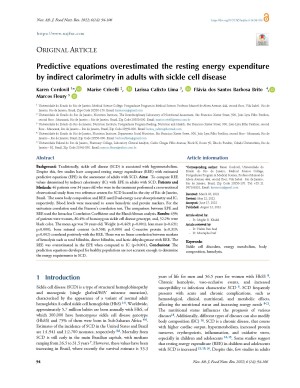Main Article Content
Predictive equations overestimated the resting energy expenditure by indirect calorimetry in adults with sickle cell disease
Abstract
Background: Traditionally, sickle cell disease (SCD) is associated with hypermetabolism. Despite this, few studies have compared resting energy expenditure (REE) with estimated predictive equations (EPE) in the assessment of adults with SCD. Aims: To compare REE values determined by indirect calorimetry (IC) with EPE in adults with SCD.
Patients and Methods: 46 patients over 34 years old who were in the treatment performed a cross-sectional observational study from two reference centers for SCD located in the city of Rio de Janeiro, Brazil. The assess body composition and REE used Dual-energy x-ray absorptiometry and IC, respectively. Blood levels were measured to assess hemolytic and protein markers. For the univariate correlation used the Pearson’s correlation test. The comparison between EPE and REE used the Intraclass Correlation Coefficient and the Bland-Altman analysis.
Results: 63% of patients were women, 80.4% of homozygous sickle cell disease genotype, and, 52.2% were black color. The mean age was 50 years old. Weight (r=0.469; p=0,001), lean mass (r=0.631; p=0.000), bone mineral content (r=0.508; p=0.000) and C-reactive protein (r=0.319; p=0.002) correlated positively with the REE. There was no linear correlation between markers of hemolysis such as total bilirubin, direct bilirubin, and lactic dehydrogenase with REE. The REE was overestimated in the EPE when compared to IC (p<0.001).
Conclusions: The prediction equations developed for healthy populations are not accurate enough to determine the energy requirements in SCD.







